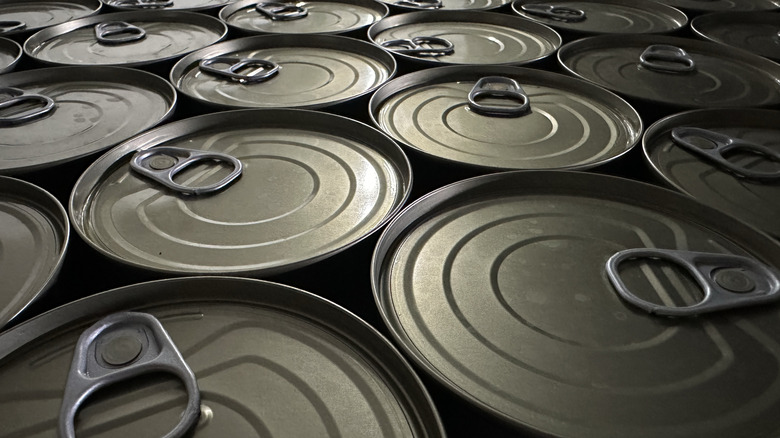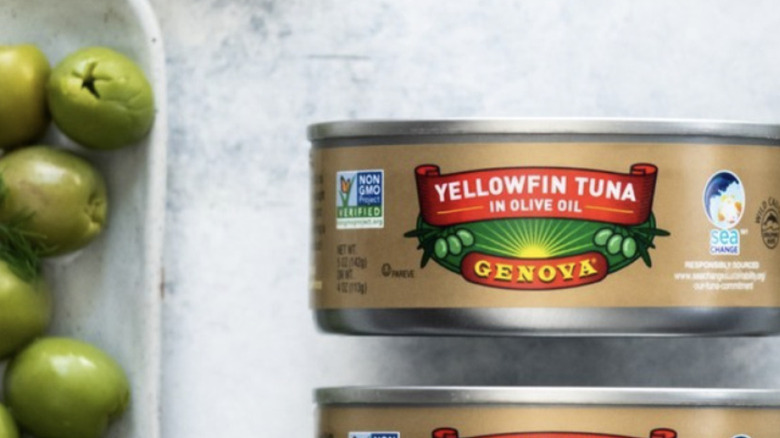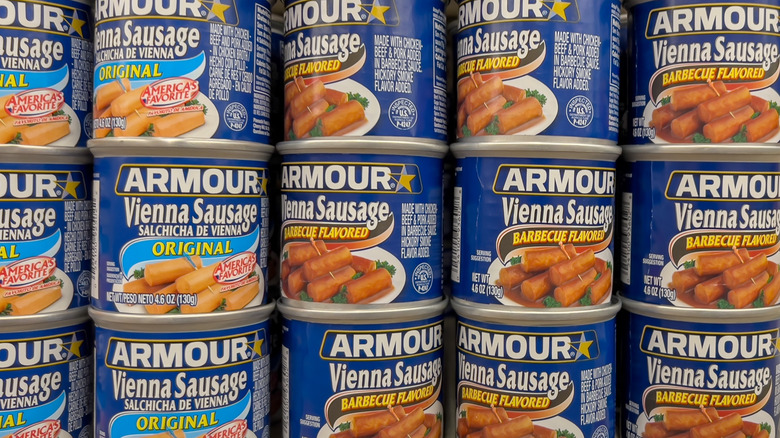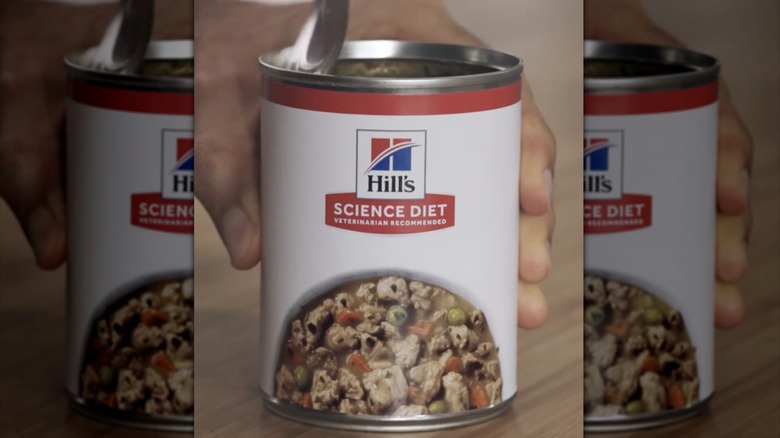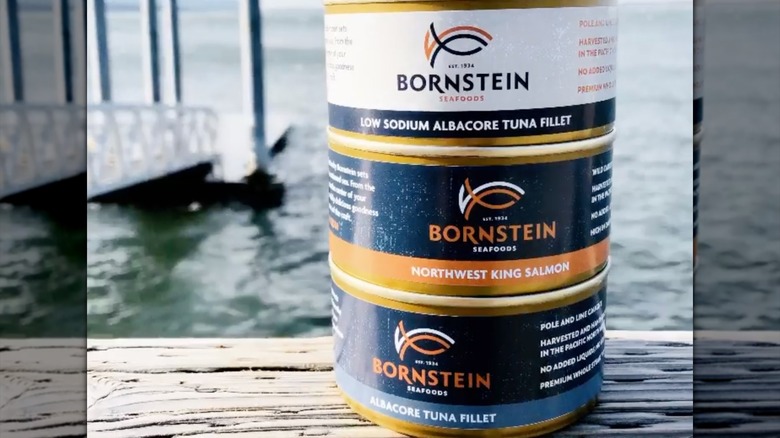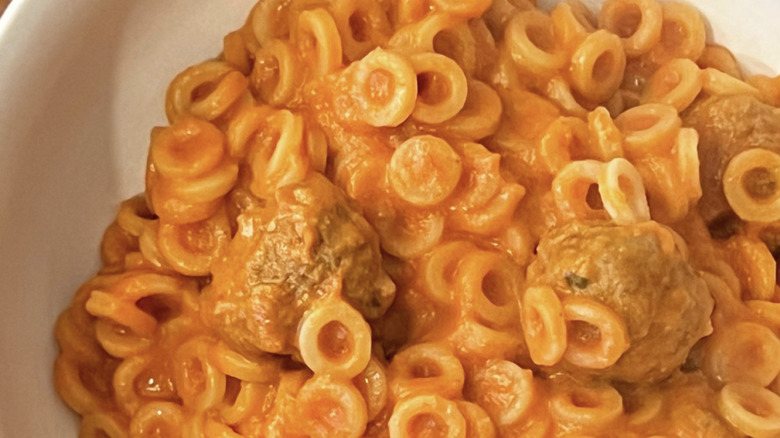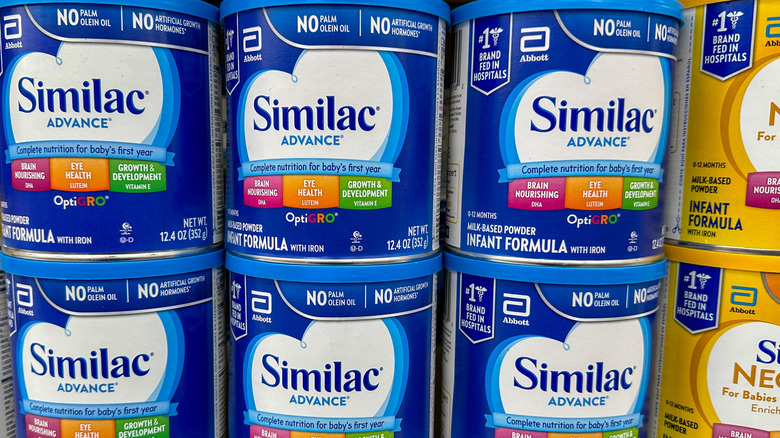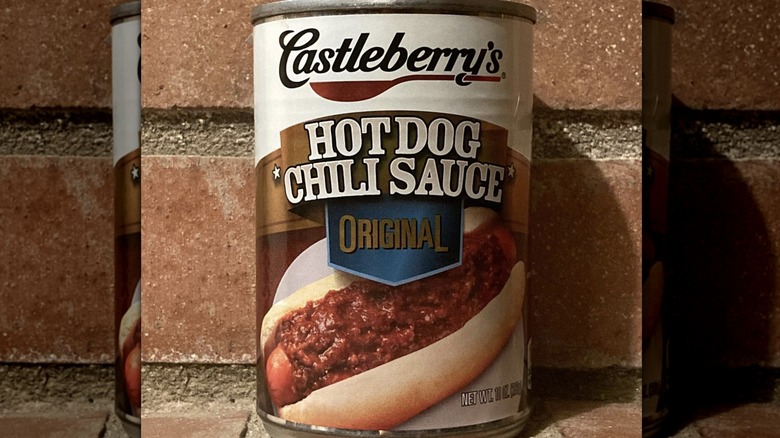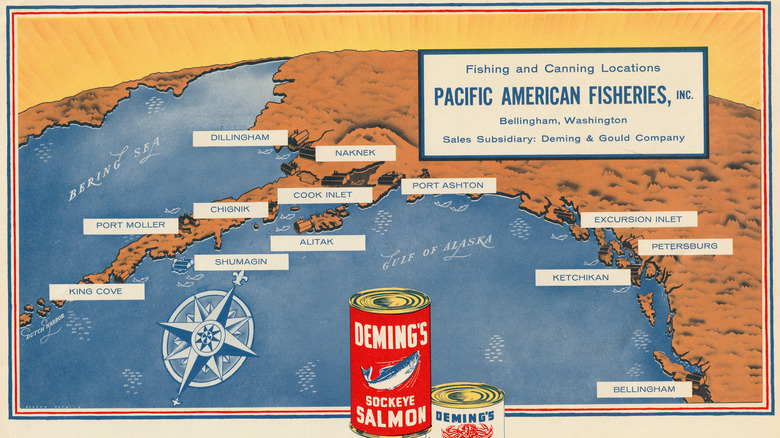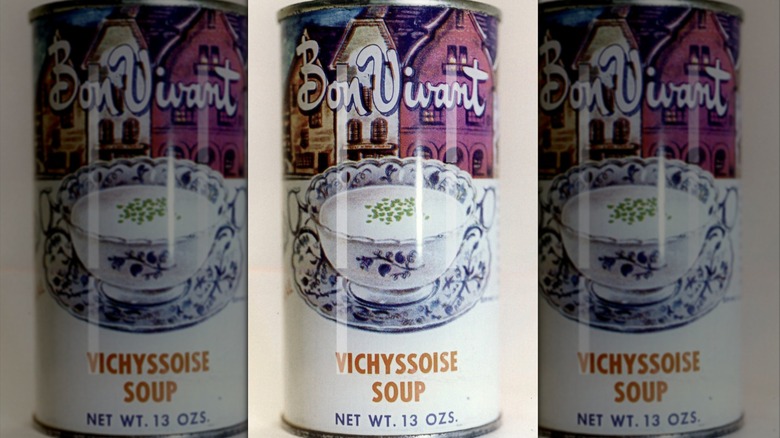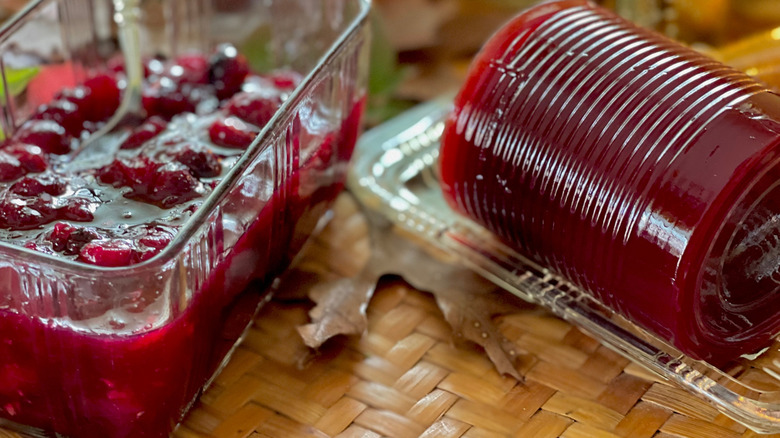The Biggest Canned Food Recalls In US History
We may receive a commission on purchases made from links.
Canned food: It's consummate convenience and peak preservation rolled into one. If there's a zombie apocalypse, it's cans (and bravery) that will usher us through. It would be easy to expound upon all the ways canned foods contribute to society, but that's not what this article is about. What we're here to discuss is the canning industry's dark side. The biggest canned food recalls in the U.S. have caused significant disruptions to modern food manufacturing.
Canned foods are pantry essentials due to their long shelf life and the immense variety of goods housed inside them. However, they also carry a higher risk of botulism than foods packaged in boxes or bags. Botulism is one of the most lethal food borne illnesses. It attacks the nervous system, causing breathing difficulty, muscle paralysis, and if left untreated it can be fatal. Toxic botulism bacteria often develop inside cans or vacuum sealed jars that aren't properly secured during the manufacturing process.
As scary as a potential brush with botulism is, it's just one of the reasons why canned foods get recalled. A can's contents are susceptible to various contaminations, including other food borne pathogens, foreign objects, or undeclared allergens. These are the calamitous scenarios that caused the biggest canned food recalls the U.S. has ever seen.
Tri-Union Seafoods Tuna in 2025
In February 2025, a concerning announcement was released by Tri-Union Seafoods, a large canned tuna distributor based in El Segundo, California. The company issued a voluntary recall of select lots of tuna due to being potentially contaminated with clostridium botulinum (C. botulinum). Tri-Union's recall included popular canned tuna brands like Genova, Van Camp's, H-E-B, and Trader Joe's.
The recall had nothing to do with the tuna inside the cans, but rather, the pull tab mechanism on the cans' lids. Tri-Union received word from its can supplier that the "easy open" pull tabs were defective, and the cans were not sealed in an air-tight manner as intended. A low-oxygen environment where low-acid food is present is precisely where botulinum bacteria grow and thrive. Botulism holds a dangerous reputation, so Tri-Union didn't hesitate to get the faulty cans out of stores.
At the time of this writing, Tri-Union's canned tuna recall is ongoing. The initial recall is comprised of 34 lot codes. Genova Yellowfin Tuna in Olive Oil and Solid White Tuna in Olive Oil make up several of those lot numbers. Two lot codes of Van Camp's Solid Light Tuna in Oil have been recalled as well. H-E-B Solid White Tuna in Water and five varieties of Trader Joe's cans, have also been affected by Tri-Union's botulism risk.
Conagra meat and poultry in 2023
If you're familiar with the superbrands of the food industry, you've probably heard of Conagra — a multi-conglomerate operation that owns brands like Banquet, Birds Eye, Duncan Hines, Healthy Choice, Swiss Miss, and more. Conagra is a gargantuan global food manufacturer, so news of a massive recall for one (or more) of its products isn't exactly an oh no they didn't kind of moment. In 2023, a recall of Conagra-made meat and poultry was one of the biggest to hit the canned food aisles of America the Beautiful.
The problem was simple: Conagra workers began noticing that some of the cans in the company warehouse were damaged, leaking, and going bad. The powers that be knew well enough that reporting these spoiled cans of meat and poultry to the FSIS (Food Safety and Inspection Service) arm of the USDA (U.S. Department of Agriculture) and launching a recall for lapse in quality control was preferable to staging some shoddy coverup (and possibly killing innocent consumers in the process).
Most of the canned goods at risk for contamination were Vienna sausages and potted meats. Some of the brand names affected were Armour, Kroger, and Goya, with Armour having the most recalled products and lot numbers by far. No known illnesses were reported in connection with the incident, but it did force Conagra to recall a total of 2,581,816 pounds of canned meat.
Hill's Science Diet dog food in 2019
Major damage control was in order for Hill's Science Diet in January 2019. Elevated levels of vitamin D in 33 varieties of Hill's canned dog food was grounds for a nationwide recall. Hill's became aware of the issue after a customer complained of their dog experiencing health issues resembling vitamin D toxicity. The company stated that the overabundance of vitamin D in its dog food was caused by a supplier error. The recall was expanded in March 2019, amassing a total of 21.6 million cans. Meanwhile, multiple lawsuits were filed against Hill's by individuals whose dogs died after eating the canned food.
The issue didn't end there. The FDA sent Hill's a warning letter in November 2019 , alleging that Hill's failed to comply with the corrective actions the FDA issued following the recall. During the investigation of Hill's Topeka, Kansas facility, inspectors found that Hill's was incorporating a supplier-obtained pre-mix of vitamins into its canned dog food without analyzing it first. FDA testing of the dog food showed vitamin D levels more than 33 times higher than the recommended upper limit. Hill's refuted the claim, saying that it requires a Certificate of Analysis for every vitamin pre-mix it receives.
Skipanon Brand Seafood in 2015
Some recalls have a domino effect, and that's exactly what Skipanon Brand Seafood started in October 2015. That September, Skipanon, a family-owned cannery in Warrenton, Oregon received a cease-and-desist order from the Oregon Department of Agriculture (ODA). A disastrous inspection performed by the ODA and FDA unveiled Skipanon's blatant lack of processing records. This forced a recall of the cannery's entire inventory.
The recall included all lots and sizes of Skipanon's canned tuna, salmon, steelhead, and sturgeon. Although no botulism bacteria was found at the facility, Skipanon's failure to keep records created a situation in which a botulism outbreak could easily occur. The recall freaked out a lot of canned fish businesses in the Pacific Northwest. Skipanon's facility also packed products for over a dozen other brands, including Ecola Seafood, Garibaldi Cannery LLC, Pacific Oyster Co., and Bornstein Seafood Inc. In total, Skipanon spawned secondary recalls from 17 canned fish companies. According to Skipanon's Facebook page, the cannery is no longer in business.
SpaghettiOs with Meatballs in 2010
Uh-Oh is right. Canned food classic SpaghettiOs with Meatballs were noticeably absent from stores in June 2010 after the FSIS pulled three varieties from circulation due to suspected under-processing. The recall quantity weighed in at 15 million pounds, making it one of Campbell's biggest recalls ever. So what was this under-processing that made the FSIS so uneasy?
A routine inspection of a plant in Paris, Texas revealed that one of the cookers intended to pre-cook the canned meatballs to a safe temperature wasn't working correctly. Since it was unclear when the cooker started malfunctioning, Campbell's pulled all SpaghettiOs cans containing meatballs processed at the plant between December 2008 and June 2010. Campbell's noted that a significant portion of the recalled cans had probably already been eaten, but no illness linked to the undercooked meatballs was reported.
The USDA reported that 3,772,102 pounds of SpaghettiOs with meatballs were recovered. The under-processing snafu was given a Class I recall level — the most dangerous designation. Consuming undercooked beef products presents a significant risk of E.Coli infection. Concurrently, eating improperly heated canned food items puts consumers in danger of ingesting C. botulinum bacteria. Both E.Coli and botulism are potentially deadly foodborne illnesses.
Similac powdered baby formula in 2010
Baby formula recalls are always particularly unnerving, and the one that affected Similac powdered formula in September 2010 was creepy too. Abbott Laboratories, which produces Similac, recalled approximately five million cans of powdered formula because it possibly contained beetles. When a small beetle was found inside the formula being made at Abbott's Sturgis, Michigan facility, the company halted production and recalled its already shipped product. The recall affected powdered formula only.
The cans of Similac were sold nationwide, as well as in Guam, Puerto Rico, and select Caribbean nations. Aside from being gross, what made beetles in baby formula so disturbing in Similac's case was the type of beetle that had wiggled its way onto the production line. Although it was ambiguously described by Abbott as a "common beetle," the recall warned consumers that if the beetle or its larvae was ingested by an infant, it could irritate the gastrointestinal tract and cause a loss of appetite. Needless to say, numerous class action lawsuits were filed against Abbott over the recall, with some alleging the firm waited a week to recall the contaminated product.
Castleberry's chili sauce in 2007
Getting botulism from commercially canned foods seems like an olden times problem, but Castleberry's proved everyone wrong when its chili sauce was behind a major botulism outbreak in July 2007. Right in the middle of hot dog season, health officials in Indiana and Texas each reported two cases of what looked like botulism-induced illnesses. The four individuals became so sick they needed to be hospitalized and put on ventilators. All of them had recently eaten Castleberry's chili sauce.
A pair of child siblings in Texas and a married couple in Indiana each displayed typical botulism-related symptoms such as cranial nerve palsies and descending paralysis. On July 18, 2007, the FDA issued a public health advisory for Castleberry's canned chili sauce. One day later, Castleberry's recalled multiple products that were manufactured at the same facility as the chili sauce that had likely made these individuals so ill.
The FDA could not obtain testable remnants from the exact cans of chili the ill individuals consumed, save for an unlabeled plastic bag of leftover chili mixture in the Indiana couple's fridge (that tested positive for botulinum type A toxin). The FDA and FSIS inspected Castleberry's Atlanta, Georgia plant and found clear problems with its production equipment. On July 21, 2007, the recall was expanded to include 91 types of Castleberry's chili sauce sold under 25 brand names.
Salmon in 1982-1983
The canned salmon industry is big business in Alaska, but in the early 1980s, a series of recalls had the public shaken up. In February 1982, A 27-year-old Belgian man named Eric Mathay died after eating Alaskan canned salmon contaminated with botulism. An FDA-led investigation of the death revealed that the can Mathay ate from had a small puncture in it, allowing the toxic botulinum spores to enter. Nine Alaskan canneries recalled all cans of salmon manufactured in 1980 and 1981 — approximately 60 million cans.
In April 1982, 68-year-old Ida Smith was admitted to a hospital in Hartford, Connecticut paralyzed and unable to speak. She had eaten canned salmon before falling ill. Sales of canned salmon packed in Alaska ceased in the U.S. and throughout the world. In England, health officials found a can of Alaskan salmon with a puncture hole similar to the one in the can that killed Mathay. When the FDA inspected a cannery in Ketchikan, Alaska, they pointed to a machine responsible for reshaping cans as the culprit for the punctures.
It was the second largest canned food recall in U.S. history and brought the Alaskan canned salmon business to its knees. The problems persisted. In 1983, the Chignick Canning Company recalled 1.6 million cans of salmon from its Alaskan cannery after discovering that equipment used to heat the salmon to a bacteria-killing temperature wasn't functioning properly.
Mushrooms in 1973
One of the food safety rules drilled into our heads as children is to beware of bulging or dented cans — what's inside could cause botulism. In early 1973, employees at the United Canning Company of East Palestine, Ohio observed a bulging six-pound, nine-ounce can of mushrooms in the warehouse and knew they had a problem. When the FDA was clued in and ran tests, the giant can was found to contain botulinum type B toxin. The company recalled 39,500 units.
The mass recall of industrial-sized mushroom cans resulted in multiple frozen pizza distributors recalling inventory as well. On February 9, 1973, 44,000 frozen pizzas made by Fabbrini Family Foods were dumped into a Ossineke, Michigan Landfill. The day is remembered as the Great Michigan Pizza Funeral. The recall also led to a full-scale investigation of restaurants and wholesalers that might be in possession of contaminated cans. When a single lot of mushrooms supplied by Fran Mushroom Company tested positive for botulinum toxin the FDA ordered the company to recall 500,000 pounds.
More frozen meals containing mushrooms were being recalled by the tens of thousands. The FDA inspected over 4,000 warehouses in 60 days. The count of recalled mushrooms reached 75 million cans — the largest canned food recall the U.S. had ever seen.
Bon Vivant Vichyssoise in 1971
Bon Vivant's attempt to popularize one of the classic French recipes in the U.S. killed a human being — and Bon Vivant's professional future. In the summer of 1971, Samuel Cochran Jr. of Bedford Village, New York, died from type A botulism hours after sharing a can of Bon Vivant vichyssoise with his wife (who survived, but was paralyzed). Days later, Bon Vivant recalled all of its vichyssoise, which was sold under at least 22 different brand names.
Bon Vivant insisted that one 6,444-can lot of its vichyssoise warranted concern and the others were fine. The National Canners Association refused to reveal Bon Vivant's other brand names, but a state health official spilled that info to the press. The FDA sued Bon Vivant and ordered for 1.5 million cans of soup manufactured in its Newark, New Jersey plant to be destroyed. An FDA inspector who visited the plant testified about witnessing numerous instances of soup ingredients being undercooked or cooked in malfunctioning equipment. Frayed asbestos and pipe leaks near production lines were also observed.
Within a month, Bon Vivant filed for bankruptcy. The company's downfall created widespread skepticism of America's processed food industry and compromised the public's belief that the FDA would keep them safe. The incident was also a catalyst for Congressional bills like the Honest Label Act, introduced in 1971 , and the Consumer Food Labeling Act, introduced in 1981.
Tuna in 1970
The average tuna lover is probably aware that it's high in mercury, but how much is too much? This question has been part of the public discourse on canned tuna since a big mercury-related recall in 1970. The situation kicked off when a chemistry professor in New York tested the mercury level of some canned tuna he had in his pantry. The results showed a mercury content that far surpassed the FDA-recommended level. In response, the FDA recalled nearly one million tuna cans from store shelves.
Prolonged over-consumption of methylmercury (aka the organic mercury found in seafood) is known to cause neurological damage in humans. Mercury can impair cognitive development in fetuses and children, cause memory problems, and decrease motor skills. Adults may experience memory loss, depression, numbness, or difficulty walking and talking. In conjunction with the 1970 tuna recall, the FDA also stated that fish with mercury content exceeding 0.5 parts per million (ppm) may be subject to further recalls.
Members of the commercial fishing industry objected so strongly to this federal guideline that they sued the FDA in 1979. The FDA loosened the restriction to no more than 1 ppm. It's one of the most lax actionable levels for mercury content in seafood worldwide.
Cranberry sauce in 1959
On November 9, 1959, meal-planning for Thanksgiving — which was just over two weeks away — took a dramatic turn. An old standby of the Turkey Day spread was stricken from shopping lists from coast to coast: cranberry sauce. Why? Because Arthur S. Flemming, the Secretary of Health, Education, and Welfare at the time, issued a nationwide alert that some cranberries grown in the Pacific Northwest had been contaminated with a weed killer called aminotriazole, and it was known to cause thyroid tumors in rats. In 1958, an Amendment to the 1938 Food, Drug, and Cosmetics Act federally banned the use of any cancer-inducing additives.
Canned cranberry sauce wasn't one of the foods served at the first Thanksgiving, but folks in the mid-20th century loved it — until November 1959. Cranberry cocktail heavyweight Ocean Spray attempted to soothe the public, insisting the only way someone could be sickened by the chemical-laced cranberries was if they consumed carloads of it. Flemming called for cranberry companies to withdraw their products from the market for government testing. Days before Thanksgiving, 16 million pounds of cranberries were declared safe to eat, but the general public was too bogged down by fear. Even President Eisenhower opted for applesauce that year.
Olives in 1919
The tragic botulism-meets-olive ordeal of 1919 reads more like an Agatha Christie novel than the FDA-issued recalls we see today. A fateful dinner party staged the scene, and the seating arrangement determined who wound up dead. On August 23rd, Mrs. I.W.G. hosted 200 guests at a country club near Canton, Ohio. In addition to the banquet foods on the menu, I.W.G. served ripe olives and assorted sweets at her table only.
Several of I.W.G's chosen VIPs noted that the olives tasted weird. Word traveled, so a chef and two servers also tasted the olives (which were technically jarred, not canned). All three employees and 11 guests became ill. The chef, one server, and five guests died (including I.W.G.). The investigation that followed determined that all of the deceased had eaten the olives and the vacuum seal on the jar they came from was faulty. Testing on the remaining olives came back positive for Bacilli botulini.
This incident, along with a handful of others in late 1919 and 1920, killed 18 people. All of the deaths were linked to jarred or canned black olives from California. To prevent widespread panic from tanking America's canned food industry, the canning business and the olive business united to fund a Botulism Commission. The Commission's research led to stricter processing regulations for olives (and later, other canned foods), including heating at 240 degrees Fahrenheit for a minimum of 40 minutes and more thorough inspection services.
